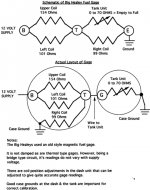Hi Bob,
If the dash part of the gage is connected properly, a quick check of the panel gage is to remove the wire connection to the sender at the sender end. With no connection to this wire, the gage should read somewhere around full. With this same wire grounded the gage should read empty.
With the tank empty or the sender float down, & it's wire disconnected, the gage sender should read near zero ohms when checked with an ohmeter connected from the sender terminal to ground. With the float up the ohmeter should read around 70 ohms. Note: the sender ohm readings could actually vary from 70 ohms to about 90 ohms with the float up & from around 10 ohms to zero with the float down.
Make sure that both the dash gage case & the sender case have "good" ground wire connections. A poor ground on the gage case can result in a gage that reads about 30% low. A poor ground at the sender can cause erratic gage readings. Not that they don't bounce around anyway as fuel sloshes around in the tank.
If the wire between gage & sender is open or not making connection the dash gage will always read full. if this wire was grounded somewhere along the line, the gage would always read empty.You could try a temporary wire from gage to sender. If the sender check shows opposite to these readings, you have the wrong sender.
You can do these checks with the sender removed & just raise/lower the float arm. You do need a temporary jumper from the sender housing to ground for the test.
When installing the sender, make sure that the sender to tank gasket is in good condition & sealed, the top lid on the sender is sealed, & that the sender hold down screws are sealed & have copper washers under the heads. Lot of places for leaks & the resulting gas fumes in the boot.
D

 Hi Guest!
Hi Guest!

 smilie in place of the real @
smilie in place of the real @
 Pretty Please - add it to our Events forum(s) and add to the calendar! >>
Pretty Please - add it to our Events forum(s) and add to the calendar! >> 

